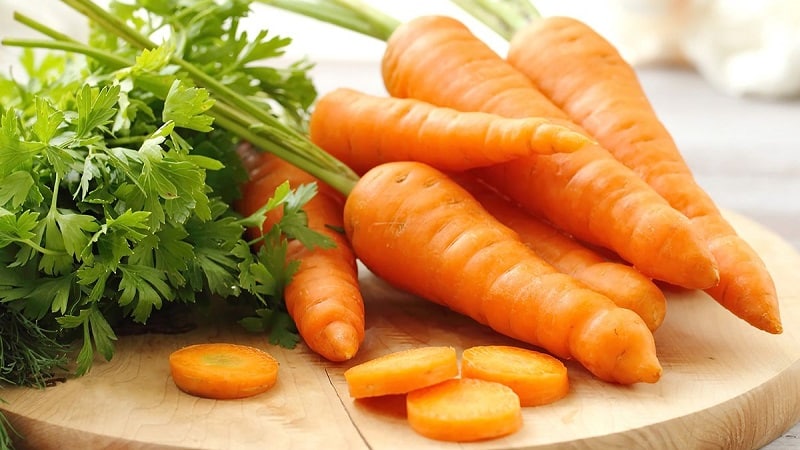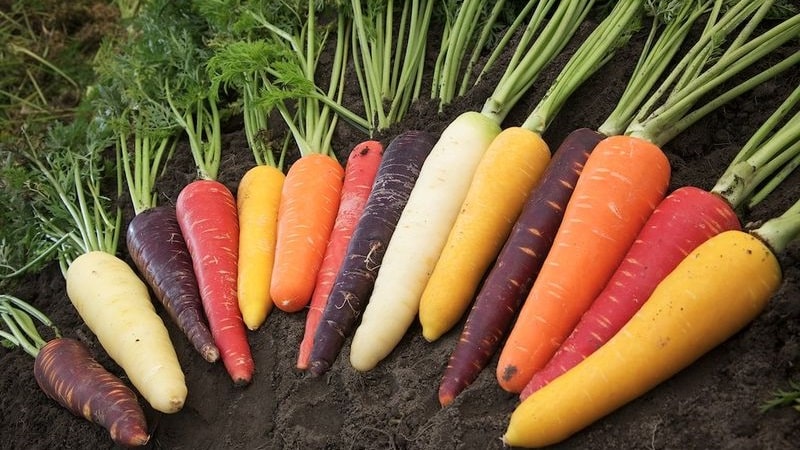Carrots - what kind of plant is it, how much does it weigh, what does it consist of - all about carrots
Carrots are among the top 10 most popular vegetables in the world. It began to be grown in Afghanistan for its fragrant leaves and seeds. The root of the plant was consumed as food already in the 1st century AD. e. The root crop was brought to Europe and Russia in the 9th century. and quickly gained popularity. Let's tell you all about carrots.
What are carrots?
Carrots are a biennial plant developed through selection from wild species.. There are table and fodder varieties. The former are used as human food, the latter are used as animal feed.

What botanical family does it belong to?
Carrot is a genus of plants from the Apiaceae family.. The plant consists of a massive root crop and a lush bunch of highly dissected feathery leaves. Blooms in the second year. The inflorescences are umbellate, with small white or yellowish flowers.
The seeds are oval-shaped, binary, flattened, up to 4 mm long, fragrant, used as a spice. The leaves are added to salads or teas. The main value is the dense, juicy, sweet root vegetable with a specific aroma.
What does it consist of?
The value is determined by the taste and chemical composition of the root crop.
100 g of product contains:
- B vitamins – 1.539 mg;
- beta-carotene – 12 mg;
- vitamin A(RE) – 2000 mcg;
- vitamin C – 5 mg;
- vitamin E (TE) – 0.04 mg;
- vitamin PP (niacin equivalent) – 1.1 mg;
- vitamin H (biotin) – 0.06 mcg;
- vitamin K (phylloquinone) – 13.3 mcg;

- calcium – 27 mg;
- magnesium – 38 mg;
- sodium – 21 mg;
- potassium – 200 mg;
- phosphorus – 55 mg;
- chlorine – 63 mg;
- sulfur – 6 mg;
- iron – 0.7 mg;
- zinc – 0.4 mg;
- iodine – 5 mcg;
- copper – 80 mcg;
- manganese – 0.2 mg;
- selenium – 0.1 mcg;
- chromium – 3 mcg;
- fluorine – 55 mcg;
- molybdenum – 20 mcg;
- boron – 200 mcg;
- vanadium – 99 mcg;
- cobalt – 2 mcg;
- lithium – 6 mcg;
- aluminum – 326 mcg;
- nickel – 6 mcg;
- organic acids – 5 g;
- mono- and polysaccharides – 14 g;
Carrot - low calorie product (35 kcal per 100 g), therefore indispensable on diets.
Rich The chemical composition and low calorie content provide carrots with an important place in the human diet.:
- The root vegetable is rich in vitamin A, which strengthens vision and improves its sharpness. Just 20 g of product provides the daily requirement.
- An almost complete complex of B vitamins helps in the functioning of the nervous and muscular systems and is involved in hematopoiesis.
- Microelements (cobalt, vanadium, iodine, manganese) regulate the functioning of the endocrine system.
- Amino acids normalize metabolism.
- Vitamin E is involved in tissue regeneration and rejuvenates the body.
- Organic acids protect against infections and participate in the breakdown of fats.
- Magnesium and potassium improve the functioning of the heart and blood vessels.
- Anthocyanins - natural dyes, strong antioxidants - fight infections and participate in the absorption of fats.
Carrots are included by the UN in the list of essential foods for humanity.
Reference. If you eat a large amount of carrots, hypervitaminosis of vitamin A is possible. The daily norm is 2-3 root vegetables per day.
Description and characteristics
The carrot fruit accumulates nutrients as it grows. The section shows 2 layers:
- the outer (bark) is covered with skin - this is the juicy, sweet part of the carrot;
- the inner core (wood) is more dense.
Breeders strive to develop varieties so that wood makes up no more than 25-30% and in taste it was close to the bark of a root vegetable.

How many grams does one medium carrot weigh?
The weight of carrots depends on the variety and ranges from 30 to 300 g. A root crop measuring 15-20 cm has an average weight of 150-200 g.
When buying in a store, it is better to choose medium-sized, intensely colored vegetables. They contain a higher concentration of nutrients.
What color is the root vegetable?
Nowadays there are many carrot varieties. Root vegetables have different colors - from white to purple. European varieties are colored mainly in red-orange colors, Asian varieties are colored white, yellow, purple shades.
Orange varieties were developed in Holland in 1721. They contain a lot of carotene, hence the shade. In the body, the pigment is converted into vitamin A. White varieties of carrots have almost no carotene in their composition. Red carrots, along with carotene, contain lycopene, an antioxidant that breaks down fats.
The root vegetable owes its burgundy hues to betaine., which protects the heart and controls muscle growth. Yellow carrots contains lutein, it is needed for the eyes and heart.
If the content of anthocyanins is increased, carrots become purple and even black. Anthocyanins are antioxidants that prevent inflammation and break down fats.
For reference. The more intense the color of the root crop, the higher the content of useful substances.
The photo shows multi-colored carrots.

Form
The shape of the root crop can be:
- round (varieties Rondo, Parmex, Vnuchka, etc.);
- cylindrical (Amsterdamskaya, Lenochka, Lyubimaya, etc.);
- conical (Alenka, Minicore, etc.).
Also, during the growth process, root crops can take on an oval shape or in the form of a truncated cone.
When there is drought or uneven watering, the carrots bend and the bark cracks.
Root system
The root system of carrots is taprooted, grows quickly and develops intensively. A strong and long root grows even before the formation of real leaves when planting. It can go to a depth of up to 2 m.
In the upper part the root is fleshy and thickened. An extensive network of suction roots up to 60 cm deep extends from it. The root crop is formed from the thickening of the main root, its upper part, due to the deposition of nutrients.
What color were carrots originally?
Carrots began to be cultivated from wild species growing in the territory of modern Iran and Afghanistan more than 4 thousand years ago. From there it came to China and Japan, the Mediterranean and Europe.
Reference. The carrot pollen found in geological strata is 36 million years old.
Ancient types of carrots had yellow and purple colors. The leaves and seeds of the plant were used as a spice and medicine. The first cultivated varieties were developed by the 1st century AD. e. Since these times, carrots began to be eaten as a root vegetable.
During the cultivation process, plants with sweeter roots were selected for sowing. With each season, the quality of root crops improved, they became more and more juicy. As a result of selection, many varieties with different colors of root crops were developed. In Asia, yellow and purple are still popular. They are even used to produce strong drinks.
The most popular orange carrot was developed in Holland in the 17th century.. The change in color of the root crop during selection is due to the different content of certain substances in its composition.
Conclusion
Carrots should be present in every person's diet. It goes well with other vegetables, boiled or fresh, and serves as a source of vitamins, antioxidants and minerals.
This is a beautiful, bright and tasty root vegetable that has various beneficial properties depending on its color and color saturation.